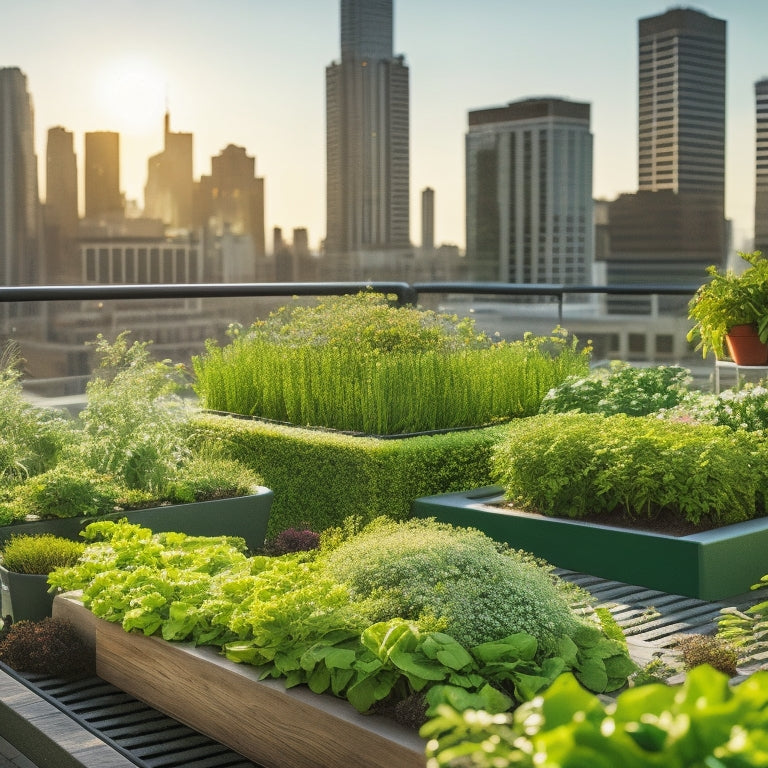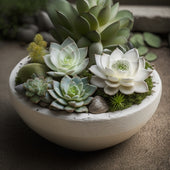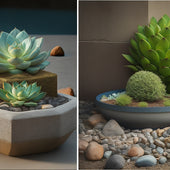
Growing Fresh Produce on Rooftops With Hydroponics
Share
You're taking urban agriculture to new heights by growing fresh produce on rooftops with hydroponics. By optimizing crop yields through precision-controlled light, temperature, and nutrient delivery systems, you're increasing air quality, reducing transportation emissions, and mitigating the urban heat island effect. When designing your rooftop garden, consider the right hydroponic system for your space and crop selection, and don't forget to implement proper lighting solutions and maintain a healthy ecosystem. As you navigate the world of rooftop hydroponics, you'll discover more innovative ways to overcome common challenges and reap the many benefits of this cutting-edge growing method.
Key Takeaways
• Rooftop hydroponics increases crop yields by optimizing growing conditions, improving air quality, and utilizing unused urban spaces.
• Choosing the right hydroponic system, such as NFT, DWC, or Ebb and Flow, depends on rooftop conditions and crop types.
• Crop selection should consider local climate, rooftop conditions, and temperature and humidity tolerance for a balanced and nutritious harvest.
• Implementing proper lighting solutions, such as LED technology, and climate control is crucial for optimal plant growth and yields.
• Regular monitoring of pH levels, nutrient levels, and oxygenation is necessary to maintain a healthy rooftop ecosystem and prevent common challenges.
Benefits of Rooftop Hydroponics
By adopting rooftop hydroponics, you can reap numerous benefits, including increased crop yields, improved air quality, and enhanced energy efficiency. This innovative approach to urban agriculture offers a sustainable way to produce fresh produce, reducing the carbon footprint of traditional farming methods. Rooftop hydroponics also provide a unique opportunity to repurpose underutilized urban spaces, turning rooftops into productive areas that contribute to the local food supply.
One of the most significant sustainability benefits of rooftop hydroponics is the reduction of transportation emissions. By growing produce locally, you can eliminate the need for long-distance transportation, reducing greenhouse gas emissions and supporting the local economy.
Additionally, rooftop hydroponics can help mitigate the urban heat island effect by providing a cooling effect through evapotranspiration. This approach also conserves water, using up to 90% less than traditional farming methods.
Choosing the Right Hydro System
You'll need to select a hydroponic system that aligns with your rooftop's specific conditions, available space, and the type of crops you want to grow.
There are several system types to take into account, including NFT (nutrient film technique), DWC (deep water culture), and Ebb and Flow (flood and drain) systems. Each has its pros and cons, so research and choose the one that best suits your needs. For instance, NFT systems are ideal for leafy greens and herbs, while DWC systems are better suited for larger crops like tomatoes and cucumbers.
When selecting a system, think about the nutrient solutions you'll need to provide your crops. You'll need to choose a solution that's specifically formulated for hydroponic growing and tailored to the type of crops you're growing.
Look for solutions that are pH-balanced and contain the necessary macronutrients and micronutrients for optimal growth. Some systems may also require additional equipment, such as pumps, timers, and irrigation systems, so be sure to factor these into your overall plan.
Designing a Rooftop Garden Layout
Your rooftop garden's layout will depend on the hydroponic system you've chosen, the space available, and the type of crops you're growing. It's essential to create a well-planned design that accommodates these factors.
Reflect on the vertical gardening approach to maximize space optimization, as it allows for more plants to be grown in a smaller area. This is especially important for rooftop gardens, where space is often limited.
When designing your layout, think about the flow of water, nutrients, and air throughout the system. Make certain that each plant has adequate access to these essential resources.
You'll also want to take into account the weight and structural integrity of your rooftop, as well as any local building codes or regulations.
To make the most of your space, contemplate using a trellis system or a wall-mounted planter. These will help to keep your plants organized and upright, while also adding visual interest to your rooftop garden.
Selecting the Best Crops to Grow
When selecting crops for your rooftop hydroponic garden, you'll need to take into account several key factors to guarantee success.
You'll want to choose crops that thrive in your local climate and can tolerate the unique conditions found on rooftops, such as intense sunlight and wind.
Crop Selection Criteria
Crops that thrive in controlled environments and can tolerate a wide range of temperatures and humidity levels are ideal for rooftop hydroponics. When selecting the best crops to grow, you should take into account crop diversity to guarantee a balanced and nutritious harvest. This can be achieved by growing a mix of leafy greens, herbs, fruits, and vegetables. For instance, you can grow leafy greens like lettuce and kale, herbs like basil and cilantro, and vegetables like tomatoes and cucumbers.
Seasonal adaptability is another vital factor to take into account. Choose crops that can thrive in the local climate and adjust your selection according to the changing seasons. For example, you can grow cool-season crops like broccoli and carrots in the spring and fall, while warm-season crops like peppers and eggplants do well in the summer.
Ideal Roof Conditions
You'll want to assess your rooftop's conditions to determine which crops will thrive in its unique environment. This is essential in selecting the best crops to grow using hydroponics. Rooftop conditions can vary greatly, and understanding these factors will help you make informed decisions.
Some key factors to take into account are:
-
Sunlight exposure: Most crops require at least 4-6 hours of direct sunlight per day. If your rooftop receives partial shade, you may want to opt for shade-tolerant crops like lettuce or herbs.
-
Wind protection: Strong winds can damage plants and disrupt hydroponic systems. If your rooftop is exposed to harsh winds, think about using windbreaks or selecting crops that are more resistant to wind stress.
-
Temperature extremes: Rooftops can be prone to extreme temperatures, which can affect crop growth. Be sure to choose crops that are tolerant of temperature fluctuations or provide adequate temperature regulation measures.
Implementing Proper Lighting Solutions
By selecting the right type of lighting for your rooftop hydroponics system, you can considerably boost plant growth and yields. LED technology has revolutionized the field of hydroponic lighting, offering a range of benefits over traditional lighting methods.
When choosing a lighting solution, consider the light spectrum required by your plants. Different spectrums promote different growth stages, such as:
| Light Spectrum | Growth Stage | Effect |
|---|---|---|
| Blue (400-500nm) | Vegetative growth | Promotes leaf growth and development |
| Red (600-700nm) | Flowering and fruiting | Enhances fruit production and color |
| Green (500-600nm) | General growth | Supports overall plant development |
| IR (700-800nm) | Root growth | Stimulates root development |
| UV (300-400nm) | Defense mechanisms | Triggers natural defense responses |
Maintaining a Healthy Rooftop Ecosystem
As you establish your rooftop hydroponics system, you'll need to focus on maintaining a healthy ecosystem.
You'll want to implement soilless growing methods that promote healthy root development and efficient nutrient uptake.
Soilless Growing Methods
In a rooftop hydroponics system, managing soilless growing methods is crucial to maintaining a healthy ecosystem, where plants receive precise amounts of nutrients and water.
As you explore vertical farming on your rooftop, you'll need to take into account the unique challenges and benefits of soilless growing. Without soil, your plants rely on you to provide the necessary nutrients, which can be done through carefully crafted nutrient solutions.
To guarantee a thriving ecosystem, keep the following in mind:
-
Monitor pH levels: Regularly check the pH levels of your nutrient solutions to make sure they're within the ideal range for your plants.
-
Control nutrient levels: Adjust the concentration of nutrients in your solutions based on the growth stage and needs of your plants.
-
Maintain adequate oxygenation: Ensure that your hydroponic system provides sufficient oxygen to the roots of your plants, promoting healthy growth and development.
Rooftop Climate Control
Controlling rooftop climate conditions is vital to maintaining a healthy ecosystem, where temperature, humidity, and light levels must be carefully regulated to enhance plant growth and development.
You'll need to guarantee that your rooftop hydroponic system is designed to manage these factors effectively.
Temperature regulation is significant, as most plants thrive in temperatures between 65°F and 75°F (18°C and 24°C). You'll need to install a temperature control system that can maintain this range, even in extreme weather conditions.
Humidity management is also important, as high humidity can lead to fungal diseases and pest infestations. You can achieve ideal humidity levels by using a dehumidification system or guaranteeing good air circulation within the rooftop ecosystem.
Proper shading and insulation can also help regulate temperature and humidity levels. By controlling these climate factors, you'll be able to create an ideal environment for your plants to thrive.
With the right climate control measures in place, you'll be able to enjoy a bountiful harvest of fresh, healthy produce from your rooftop hydroponic garden.
Overcoming Common Rooftop Challenges
When designing a rooftop hydroponic system, you'll likely encounter several challenges that can impact its success. One of the primary concerns is water management strategies, as rooftops can be prone to waterlogging and drainage issues. You'll need to guarantee that your system is designed to handle excess water and prevent waterborne diseases.
-
Weight limitations: Rooftops often have weight restrictions, so you'll need to choose a hydroponic system that's lightweight yet efficient.
-
Pest control techniques: Rooftop gardens can be vulnerable to pests such as aphids, whiteflies, and spider mites. Implement Integrated Pest Management (IPM) strategies to minimize the risk of infestations.
-
Wind and weather protection: Rooftop gardens are exposed to harsh weather conditions, including strong winds, intense sunlight, and extreme temperatures. You'll need to design your system to provide adequate protection for your crops.
Frequently Asked Questions
Can I Use Rooftop Hydroponics in Areas With High Winds?
You can mitigate wind damage in rooftop hydroponics by incorporating wind protection measures, such as windbreaks or shielding, and ensuring structural considerations, like secure anchoring and robust framing, to withstand high winds.
How Do I Handle Pest Control in a Rooftop Garden?
When trekking through a dense forest, you'd carefully avoid unwanted critters; similarly, in your rooftop garden, you'll need pest management strategies. Opt for organic pesticide options like neem oil or pyrethrin to keep unwanted visitors at bay.
Are Rooftop Hydroponic Systems Suitable for Apartment Buildings?
When considering a rooftop hydroponic system for your apartment building, you'll need to assess space limitations and guarantee the system's weight won't compromise the structural integrity of the building, requiring careful planning and consultation with experts.
Can I Integrate My Rooftop Garden With Existing HVAC Systems?
As you envision a harmonious rooftop haven, you wonder if your HVAC systems can sync with your garden's needs. Yes, you can integrate them, optimizing energy efficiency by leveraging shared resources and streamlining system optimization.
Do Rooftop Hydroponic Gardens Require Special Insurance Coverage?
You'll need to take into account liability considerations when installing a rooftop hydroponic garden, as it may impact your existing insurance policy. Research policy options that cover unique risks, such as equipment damage or crop loss, to guarantee you're properly protected.
Related Posts
-

What Makes a Great Planter for Succulents
When selecting a great planter for succulents, you'll want to take into account a combination of factors to guarantee...
-

What Makes a Great Planter for Succulents
When selecting a great planter for succulents, you'll want to take into account a combination of factors to guarantee...
-

What Makes a Great Planter for Succulents
When selecting a great planter for succulents, you'll want to take into account a combination of factors to guarantee...
-

What Makes a Great Planter for Succulents
When selecting a great planter for succulents, you'll want to take into account a combination of factors to guarantee...
-

What Makes a Great Planter for Succulents
When selecting a great planter for succulents, you'll want to take into account a combination of factors to guarantee...
-

What Makes a Great Planter for Succulents
When selecting a great planter for succulents, you'll want to take into account a combination of factors to guarantee...
-

What Makes a Great Planter for Succulents
When selecting a great planter for succulents, you'll want to take into account a combination of factors to guarantee...
-

What Makes a Great Planter for Succulents
When selecting a great planter for succulents, you'll want to take into account a combination of factors to guarantee...
-

What Makes a Great Planter for Succulents
When selecting a great planter for succulents, you'll want to take into account a combination of factors to guarantee...
-

What Makes a Great Planter for Succulents
When selecting a great planter for succulents, you'll want to take into account a combination of factors to guarantee...
-

What Makes a Great Planter for Succulents
When selecting a great planter for succulents, you'll want to take into account a combination of factors to guarantee...
-

What Makes a Great Planter for Succulents
When selecting a great planter for succulents, you'll want to take into account a combination of factors to guarantee...
-

What Makes a Great Planter for Succulents
When selecting a great planter for succulents, you'll want to take into account a combination of factors to guarantee...
-

What Makes a Great Planter for Succulents
When selecting a great planter for succulents, you'll want to take into account a combination of factors to guarantee...
-

What Makes a Great Planter for Succulents
When selecting a great planter for succulents, you'll want to take into account a combination of factors to guarantee...
-

What Makes a Great Planter for Succulents
When selecting a great planter for succulents, you'll want to take into account a combination of factors to guarantee...
-

What Makes a Great Planter for Succulents
When selecting a great planter for succulents, you'll want to take into account a combination of factors to guarantee...
-

What Makes a Great Planter for Succulents
When selecting a great planter for succulents, you'll want to take into account a combination of factors to guarantee...
-

What Makes a Great Planter for Succulents
When selecting a great planter for succulents, you'll want to take into account a combination of factors to guarantee...
-

What Makes a Great Planter for Succulents
When selecting a great planter for succulents, you'll want to take into account a combination of factors to guarantee...
-

What Makes a Great Planter for Succulents
When selecting a great planter for succulents, you'll want to take into account a combination of factors to guarantee...
-

What Makes a Great Planter for Succulents
When selecting a great planter for succulents, you'll want to take into account a combination of factors to guarantee...
-

What Makes a Great Planter for Succulents
When selecting a great planter for succulents, you'll want to take into account a combination of factors to guarantee...
-

What Makes a Great Planter for Succulents
When selecting a great planter for succulents, you'll want to take into account a combination of factors to guarantee...
-

10 Best Shade Garden Planters Using Concrete Blocks
You're about to discover the perfect way to add industrial chic to your shade garden while ensuring healthy plant gro...
-

10 Best Shade Garden Planters Using Concrete Blocks
You're about to discover the perfect way to add industrial chic to your shade garden while ensuring healthy plant gro...
-

10 Best Shade Garden Planters Using Concrete Blocks
You're about to discover the perfect way to add industrial chic to your shade garden while ensuring healthy plant gro...
-

10 Best Shade Garden Planters Using Concrete Blocks
You're about to discover the perfect way to add industrial chic to your shade garden while ensuring healthy plant gro...
-

10 Best Shade Garden Planters Using Concrete Blocks
You're about to discover the perfect way to add industrial chic to your shade garden while ensuring healthy plant gro...
-

10 Best Shade Garden Planters Using Concrete Blocks
You're about to discover the perfect way to add industrial chic to your shade garden while ensuring healthy plant gro...
-

10 Best Shade Garden Planters Using Concrete Blocks
You're about to discover the perfect way to add industrial chic to your shade garden while ensuring healthy plant gro...
-

10 Best Shade Garden Planters Using Concrete Blocks
You're about to discover the perfect way to add industrial chic to your shade garden while ensuring healthy plant gro...
-

10 Best Shade Garden Planters Using Concrete Blocks
You're about to discover the perfect way to add industrial chic to your shade garden while ensuring healthy plant gro...
-

10 Best Shade Garden Planters Using Concrete Blocks
You're about to discover the perfect way to add industrial chic to your shade garden while ensuring healthy plant gro...
-

10 Best Shade Garden Planters Using Concrete Blocks
You're about to discover the perfect way to add industrial chic to your shade garden while ensuring healthy plant gro...
-

10 Best Shade Garden Planters Using Concrete Blocks
You're about to discover the perfect way to add industrial chic to your shade garden while ensuring healthy plant gro...
-

10 Best Shade Garden Planters Using Concrete Blocks
You're about to discover the perfect way to add industrial chic to your shade garden while ensuring healthy plant gro...
-

10 Best Shade Garden Planters Using Concrete Blocks
You're about to discover the perfect way to add industrial chic to your shade garden while ensuring healthy plant gro...
-

10 Best Shade Garden Planters Using Concrete Blocks
You're about to discover the perfect way to add industrial chic to your shade garden while ensuring healthy plant gro...
-

10 Best Shade Garden Planters Using Concrete Blocks
You're about to discover the perfect way to add industrial chic to your shade garden while ensuring healthy plant gro...
-

10 Best Shade Garden Planters Using Concrete Blocks
You're about to discover the perfect way to add industrial chic to your shade garden while ensuring healthy plant gro...
-

10 Best Shade Garden Planters Using Concrete Blocks
You're about to discover the perfect way to add industrial chic to your shade garden while ensuring healthy plant gro...
-

10 Best Shade Garden Planters Using Concrete Blocks
You're about to discover the perfect way to add industrial chic to your shade garden while ensuring healthy plant gro...
-

10 Best Shade Garden Planters Using Concrete Blocks
You're about to discover the perfect way to add industrial chic to your shade garden while ensuring healthy plant gro...
-

10 Best Shade Garden Planters Using Concrete Blocks
You're about to discover the perfect way to add industrial chic to your shade garden while ensuring healthy plant gro...
-

10 Best Shade Garden Planters Using Concrete Blocks
You're about to discover the perfect way to add industrial chic to your shade garden while ensuring healthy plant gro...
-

10 Best Shade Garden Planters Using Concrete Blocks
You're about to discover the perfect way to add industrial chic to your shade garden while ensuring healthy plant gro...
-

10 Best Shade Garden Planters Using Concrete Blocks
You're about to discover the perfect way to add industrial chic to your shade garden while ensuring healthy plant gro...
-

10 Best Shade Garden Planters Using Concrete Blocks
You're about to discover the perfect way to add industrial chic to your shade garden while ensuring healthy plant gro...
-

10 Best Shade Garden Planters Using Concrete Blocks
You're about to discover the perfect way to add industrial chic to your shade garden while ensuring healthy plant gro...
-

10 Best Shade Garden Planters Using Concrete Blocks
You're about to discover the perfect way to add industrial chic to your shade garden while ensuring healthy plant gro...
-

10 Best Shade Garden Planters Using Concrete Blocks
You're about to discover the perfect way to add industrial chic to your shade garden while ensuring healthy plant gro...
-

10 Best Shade Garden Planters Using Concrete Blocks
You're about to discover the perfect way to add industrial chic to your shade garden while ensuring healthy plant gro...
-

10 Best Shade Garden Planters Using Concrete Blocks
You're about to discover the perfect way to add industrial chic to your shade garden while ensuring healthy plant gro...
-

10 Best Shade Garden Planters Using Concrete Blocks
You're about to discover the perfect way to add industrial chic to your shade garden while ensuring healthy plant gro...
-

10 Best Shade Garden Planters Using Concrete Blocks
You're about to discover the perfect way to add industrial chic to your shade garden while ensuring healthy plant gro...
-

10 Best Shade Garden Planters Using Concrete Blocks
You're about to discover the perfect way to add industrial chic to your shade garden while ensuring healthy plant gro...
-

10 Best Shade Garden Planters Using Concrete Blocks
You're about to discover the perfect way to add industrial chic to your shade garden while ensuring healthy plant gro...
-

10 Best Shade Garden Planters Using Concrete Blocks
You're about to discover the perfect way to add industrial chic to your shade garden while ensuring healthy plant gro...
-

Succulent-Friendly Drainage Solutions for Block Planters
You can create a succulent-friendly drainage system in your cinder block planters by drilling holes in the bottom of ...
-

Succulent-Friendly Drainage Solutions for Block Planters
You can create a succulent-friendly drainage system in your cinder block planters by drilling holes in the bottom of ...
-

Succulent-Friendly Drainage Solutions for Block Planters
You can create a succulent-friendly drainage system in your cinder block planters by drilling holes in the bottom of ...
-

Succulent-Friendly Drainage Solutions for Block Planters
You can create a succulent-friendly drainage system in your cinder block planters by drilling holes in the bottom of ...
-

Succulent-Friendly Drainage Solutions for Block Planters
You can create a succulent-friendly drainage system in your cinder block planters by drilling holes in the bottom of ...
-

Succulent-Friendly Drainage Solutions for Block Planters
You can create a succulent-friendly drainage system in your cinder block planters by drilling holes in the bottom of ...
-

Succulent-Friendly Drainage Solutions for Block Planters
You can create a succulent-friendly drainage system in your cinder block planters by drilling holes in the bottom of ...
-

Succulent-Friendly Drainage Solutions for Block Planters
You can create a succulent-friendly drainage system in your cinder block planters by drilling holes in the bottom of ...
-

Succulent-Friendly Drainage Solutions for Block Planters
You can create a succulent-friendly drainage system in your cinder block planters by drilling holes in the bottom of ...
-

Succulent-Friendly Drainage Solutions for Block Planters
You can create a succulent-friendly drainage system in your cinder block planters by drilling holes in the bottom of ...
-

Succulent-Friendly Drainage Solutions for Block Planters
You can create a succulent-friendly drainage system in your cinder block planters by drilling holes in the bottom of ...
-

Succulent-Friendly Drainage Solutions for Block Planters
You can create a succulent-friendly drainage system in your cinder block planters by drilling holes in the bottom of ...
-

Succulent-Friendly Drainage Solutions for Block Planters
You can create a succulent-friendly drainage system in your cinder block planters by drilling holes in the bottom of ...
-

Succulent-Friendly Drainage Solutions for Block Planters
You can create a succulent-friendly drainage system in your cinder block planters by drilling holes in the bottom of ...
-

Succulent-Friendly Drainage Solutions for Block Planters
You can create a succulent-friendly drainage system in your cinder block planters by drilling holes in the bottom of ...


